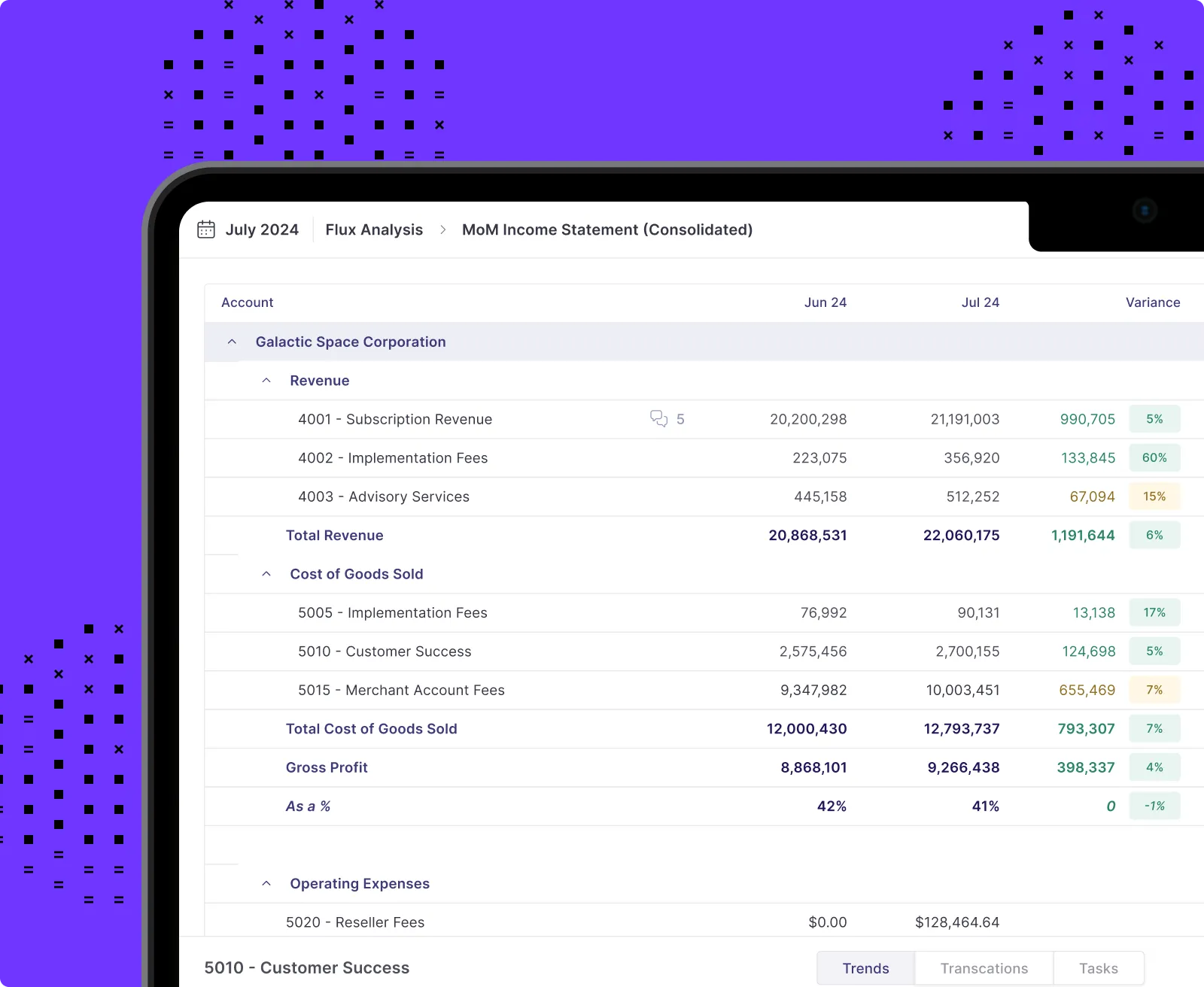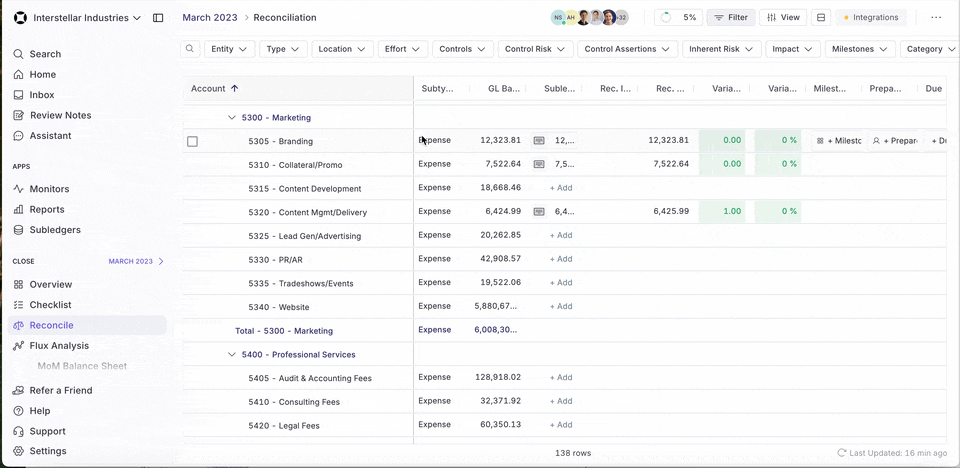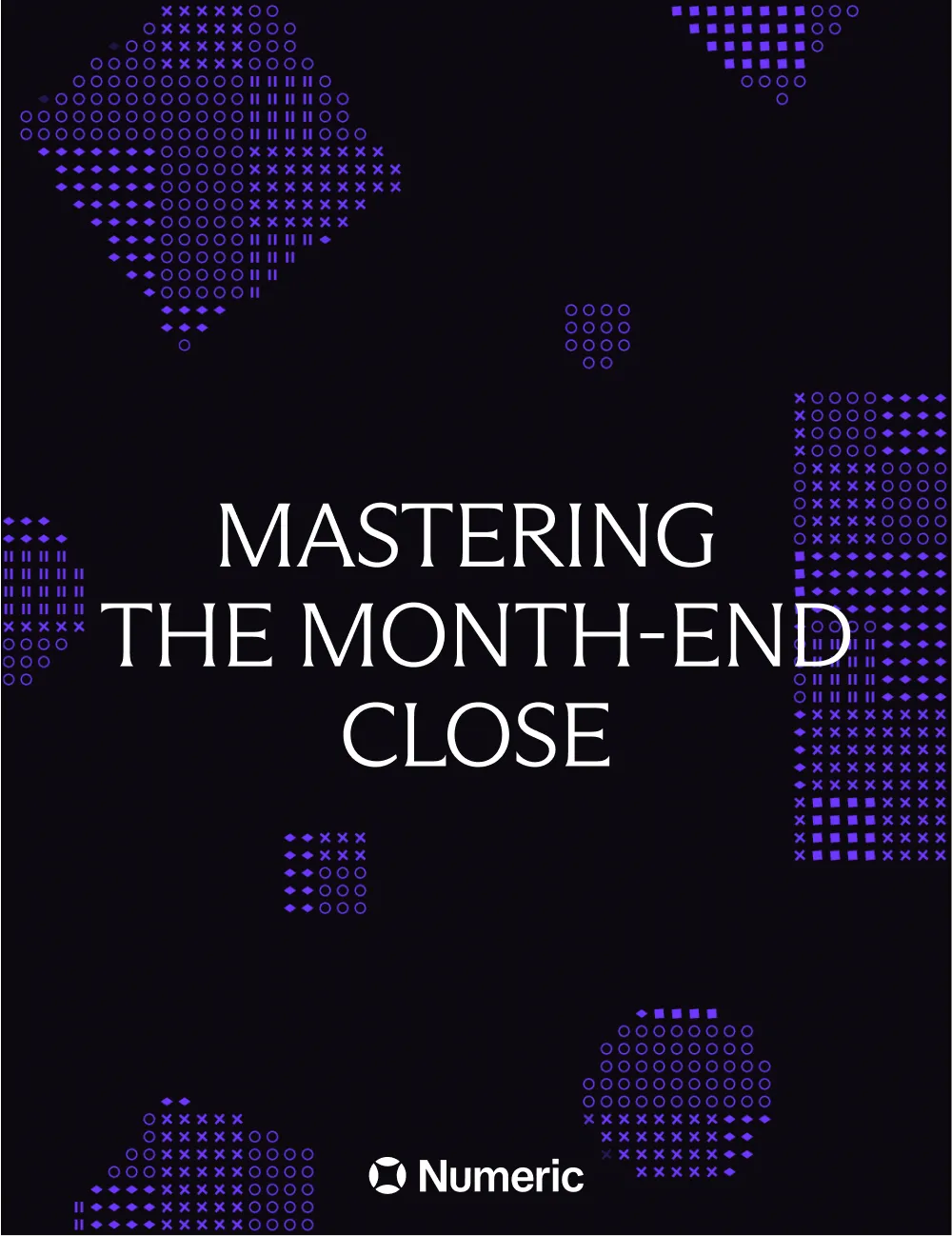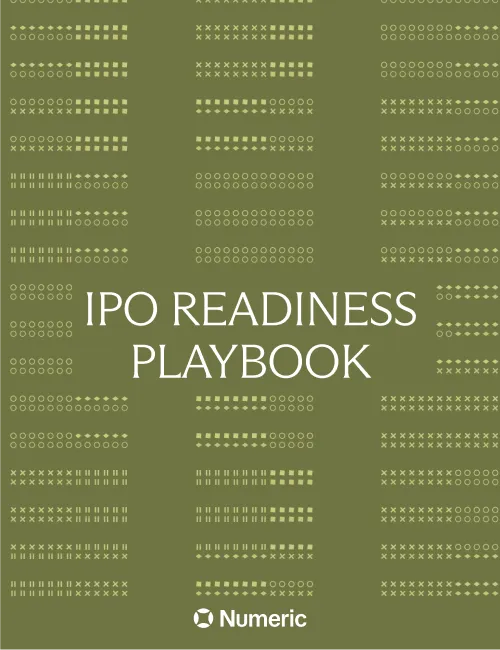Time for Month-End Reconciliations? Here's What You Need to Know
.png)
Month-end reconciliation separates the accounting teams that sleep well from those who don't. When your books balance cleanly and every account ties out, you know your financial statements reflect reality. When they don't? That's when a single missing transaction can trigger hours of detective work, delayed closes, and uncomfortable conversations with leadership about why the numbers don't add up.
The difference isn't luck—it's process. Companies that consistently nail their month-end reconciliation have moved beyond manual spreadsheet matching toward systematic approaches that catch discrepancies early and resolve them fast.
Behind every set of polished financial reports presented to executives, investors, or lenders is this rigorous verification process. It's designed to catch errors and discrepancies before they escalate into problems that could impact cash flow, decision-making, or audit outcomes.
What Is Month-End Reconciliation?
Month-end reconciliation is the systematic process of comparing and validating financial records across different sources to ensure accuracy at the close of each accounting period. It involves matching transactions between subledgers (like accounts payable, accounts receivable, and inventory) and the general ledger to identify and resolve discrepancies before finalizing financial statements.
The primary purpose is to detect errors, omissions, or fraudulent activities that could materially impact financial statements. By comparing independent sources of financial information, accounting teams can pinpoint inconsistencies that might otherwise go unnoticed until it's too late.
For most organizations, month-end reconciliation encompasses all balance sheet accounts, including cash, accounts receivable, inventory, fixed assets, accounts payable, and accrued liabilities. The scope may vary based on company size, industry, and transaction complexity.
Reconciliation vs. Month-End Close
While often used interchangeably, reconciliation is actually one component of the broader month-end close process. Reconciliation focuses specifically on verifying account balances, while the complete close includes additional activities like accruals, allocations, and financial statement preparation.
Think of reconciliation as the foundation—without solid, verified account balances, everything else in your close process becomes questionable.
Why Month-End Reconciliation Matters
Month-end reconciliation serves as the foundation for accurate financial reporting and sound business decisions. When reconciliations are performed thoroughly, companies can confidently present financial statements that truly reflect their economic reality and overall financial health.
Error Prevention and Detection Catching mistakes before they impact financial statements is far more cost-effective than discovering them during an audit or after financial statements have been issued. A small data entry error caught during reconciliation might take 10 minutes to fix; the same error discovered three months later could require amended filings and damaged credibility.
Fraud Detection and Prevention Effective reconciliation processes play a crucial role in identifying fraudulent activity. By regularly comparing independent records, accounting teams can spot unusual patterns or transactions that might indicate unauthorized activity—like duplicate vendor payments or fictitious revenue entries.
Regulatory Compliance and Audit Readiness Proper reconciliation practices are essential for meeting regulatory requirements and audit standards. Many regulatory frameworks, including SOX compliance for public companies, specifically require documented reconciliation procedures as part of internal controls. Clean reconciliations throughout the year make audit season significantly smoother.
Operational Insights Beyond compliance, reconciliation processes often highlight operational inefficiencies or system issues. Recurring discrepancies in certain accounts can point to process breakdowns, training needs, or technology gaps that impact more than just month-end close.
How Numeric Helps Accounting Teams with Month-End Reconciliation
For many teams, a key step in overcoming reconciliation hurdles is implementing a dedicated reconciliation software. With Numeric’s reconciliation product, teams like Soundstripe have gained back hours of time in their close to then focus on more strategic business initiatives.
To see just how reconciliations operate in Numeric, see this preview from Numeric’s Head of Solutions, Eli Geschwind:
What key features make month-end reconciliations a breeze in Numeric?
- Streamline your balance sheet reconciliations: With Numeric, you can handle all your month-end balance sheet recs in one spot. The system automatically pulls account totals from workpapers and your GL's trial balance. Even better, with a deep ERP integration, Numeric users can click into underlying transactions across accounts to investigate. Numeric also monitors prior period balances, flagging any changes since your last reconciliation.
- Stay organized and audit-ready with clear controls and documentation: Numeric makes it easy to assign tasks to preparers and reviewers, and keeps track of all comments, changes, and submissions in a clear month-end close checklist. When audit time rolls around, auditors can log straight into Numeric and see a complete activity trail, no need for your team to spend hours resurfacing required documentation.
- Catch anomalies with flux analysis: Easily compare accounts MoM or QoQ to spot anomalies or layer in insights with auto-generated flux reporting. With Numeric, AI takes the first pass at writing variance explanations by combing through all transaction-details in an account and identifying key drivers of change.
- Set-up ongoing transaction monitoring: With Monitors, you can flexibly set-up ongoing alerts to catch errors ahead of month-end account reconciliations. Catch any transactions tied to particular customers or, for Controllers doing a quality check of the full month-end process, surface all journal entries booked to A/R to scan through.

Steps for Effective Month-End Account Reconciliation
1. Collect and Organize Financial Records
The reconciliation process begins with gathering all relevant financial documentation for the period under review. This includes bank statements, credit card statements, subledger reports, general ledger trial balances, and supporting documentation for significant transactions.
Modern teams have largely replaced physical filing systems with digital document management, allowing for more efficient storage, organization, and retrieval of reconciliation documentation. Before beginning the actual reconciliation, perform preliminary checks to ensure all necessary reports have been generated and are complete.
Essential documentation includes:
- Bank and credit card statements
- Subledger reports from all systems
- General ledger trial balance
- Prior period reconciliations for reference
- Supporting documentation for unusual or large transactions
Pro tip: If using Numeric, these documents and balances auto-populate from your ERP integration, eliminating manual data gathering and ensuring you're always working with current information.
2. Match Subledger Data to the General Ledger
The core of reconciliation involves comparing transaction data between subledgers and the general ledger to ensure consistency across all accounting systems. This matching process identifies transactions that appear in one system but not the other, highlighting potential recording errors or timing differences.
When determining which accounts to prioritize, focus on high-volume accounts, accounts with a history of discrepancies, and accounts that are material to financial statements. Establishing materiality thresholds helps teams concentrate their efforts on differences that could significantly impact financial reporting.
For High-Volume Accounts: Use exception-based reconciliation that automatically matches obvious transactions and flags only items requiring manual review. This approach can reduce reconciliation time by 80% or more for cash and AR accounts.
For Complex Accounts: Implement systematic matching techniques like three-way matching for purchases (purchase order, receipt, invoice) or detailed transaction-by-transaction verification for investment accounts.
Effective matching techniques include:
- Automated matching for routine transactions
- Three-way matching (purchase order, receipt, invoice) for AP
- Item-by-item verification for high-value transactions
- Batch reconciliation for high-volume, low-value items
- Exception-based reviews focusing on unusual patterns
3. Investigate and Resolve Discrepancies
When reconciliation reveals differences between records, a systematic investigation process helps determine the root cause of each discrepancy. Common causes include timing differences, data entry errors, duplicate entries, missing transactions, or system integration issues.
For each identified discrepancy, prepare appropriate adjusting journal entries to correct the accounting records. These entries should follow proper accounting principles and include sufficient documentation to explain the reason for the adjustment.
Common Discrepancy Resolution Matrix:
Discrepancy Type Potential Cause Resolution Approach Transaction in bank statement but not in GL Unrecorded transaction Record journal entry with proper documentation Transaction in GL but not in bank statement Timing difference or error Verify transaction validity; record as reconciling item if timing-related Amount difference between systems Data entry error Correct the erroneous entry with adjusting journal entry Duplicate transaction in GL Processing error Reverse duplicate entry with proper documentation
Modern reconciliation tools can streamline this investigation process significantly. Teams using automated platforms like Numeric can drill down to transaction-level details instantly, reducing investigation time from hours to minutes.
4. Validate Supporting Documentation
Each reconciled transaction should be supported by appropriate documentation that verifies its accuracy and legitimacy. Supporting documentation serves as evidence during audits and provides context for future reference.
Establish clear documentation standards that specify what constitutes adequate support for different transaction types. A consistent documentation approach ensures that reconciliations meet both internal control requirements and external audit standards.
Documentation best practices:
- Standardized naming: Use consistent file naming conventions across all documentation
- Cross-referencing: Maintain clear links between transactions and supporting documents
- Version control: Track changes to reconciliation workpapers
- Digital storage: Implement cloud-based systems for easy access and backup
- Retention policies: Establish clear guidelines aligned with regulatory requirements
5. Review and Finalize Account Balances
The final step involves a comprehensive review of reconciled accounts to ensure accuracy and completeness. This review should be performed by someone other than the preparer to provide independent verification—a key internal control.
After the review, finalize the reconciliation by documenting the ending balances and obtaining necessary approvals. Many organizations use standardized reconciliation templates that include sign-off sections for preparers and reviewers.
Review checklist items:
- Verification that all material accounts have been reconciled
- Confirmation that reconciled balances match the general ledger
- Assessment of unusual reconciling items or patterns
- Evaluation of unresolved discrepancies against materiality thresholds
- Verification of proper documentation and approvals
- Sign-off by designated reviewer
Best Practices for Monthly Account Reconciliations
Visual Recommendation: Checklist-style graphic highlighting key dos and don'ts for reconciliation excellence
1. Implement a Standardized Reconciliation Checklist
Creating a standardized reconciliation checklist ensures consistency and completeness across accounting periods. This checklist should outline all accounts requiring reconciliation, associated deadlines, responsible team members, and review requirements.
Effective checklists should be tailored to your organization's specific needs while maintaining core reconciliation principles. Regularly review and update your checklist to incorporate process improvements and address emerging reconciliation challenges.
Essential checklist components:
- Account inventory: Complete list of accounts requiring reconciliation with risk ratings
- Role assignment: Designated preparers and reviewers for each account
- Timeline management: Due dates aligned with the close calendar
- Documentation standards: Required supporting evidence for each account type
- Escalation procedures: Clear process for handling unresolved discrepancies
- Sign-off requirements: Approval hierarchy for different materiality levels
For comprehensive guidance on streamlining your entire month-end process, explore our complete guide to mastering the month-end close.
2. Prioritize High-Risk and Material Accounts
Not all accounts present equal reconciliation challenges or risks. Implementing a risk-based approach allows teams to allocate resources more effectively by focusing detailed attention on accounts with higher complexity, volume, or materiality.
Materiality considerations help determine the appropriate level of precision required for different accounts. Establishing clear materiality thresholds provides guidance on when discrepancies require immediate resolution versus tracking for pattern analysis.
Typically high-priority accounts:
- Cash and bank accounts (daily activity, fraud risk)
- Accounts receivable and revenue (complex timing, material amounts)
- Inventory and cost of goods sold (valuation complexity)
- Accrued liabilities (estimation risk)
- Intercompany accounts (elimination requirements)
- Accounts with frequent manual adjustments
3. Leverage Automation and Technology
Modern reconciliation technologies have transformed what was once a highly manual process into a more automated and efficient workflow. Automation tools can match transactions across systems, flag exceptions, and generate reconciliation reports with minimal human intervention.
The key is choosing technology that integrates well with your existing financial systems and can scale with your organization's growth. Consider factors such as ERP compatibility, customization capabilities, security features, and implementation timeline.
Key automation capabilities to evaluate:
- Automated data extraction from multiple sources
- Intelligent transaction matching using configurable rules
- Exception identification and workflow routing
- Documentation management and storage
- Approval workflow automation
- Audit trail and compliance reporting
- Real-time monitoring and alerts
Teams using comprehensive platforms like Numeric often see 60-80% reductions in reconciliation time while improving accuracy and audit readiness. To see how Numeric's reconciliation platform addresses these common automation challenges, explore their automated matching and exception management capabilities.
4. Maintain Centralized Documentation
A centralized repository for reconciliation documentation creates a single source of truth that enhances collaboration and simplifies audit preparation. This repository should store reconciliation workpapers, supporting documentation, policies and procedures, and historical reconciliations.
Effective repository structures include logical organization by accounting period, account type, and entity. Access controls should balance security requirements with operational needs, ensuring sensitive financial information remains protected while enabling efficient workflow.
Repository management features:
- Consistent structure: Uniform folder hierarchies and naming conventions
- Version control: Tracking changes to reconciliation documents
- Role-based access: Permissions aligned with job responsibilities
- Search functionality: Quick retrieval of historical reconciliations
- Integration capabilities: Connection with workflow management tools
- Backup and recovery: Automated data protection
5. Monitor Performance with Key Metrics
Measuring reconciliation performance provides insights that drive continuous improvement. Key performance indicators help teams identify bottlenecks, track efficiency gains, and demonstrate the value of reconciliation process enhancements.
Regular analysis of these metrics helps identify trends and opportunities for enhancement. For example, if certain accounts consistently show high exception rates, this might indicate underlying process issues or system integration problems that need addressing.
Essential reconciliation metrics:
- Completion time: Days to complete reconciliations by account type
- Exception rates: Percentage of transactions requiring manual intervention
- Error rates: Number of adjustments required post-reconciliation
- Aging of unreconciled items: How long discrepancies remain unresolved
- Close adherence: Percentage of accounts reconciled by deadline
- Resource utilization: Hours spent on reconciliation activities by account
How Numeric Transforms Month-End Reconciliation
While many teams still struggle with manual reconciliation processes, companies using Numeric have fundamentally changed their month-end experience. Instead of spending days hunting down discrepancies in spreadsheets, teams focus on analysis and strategic insights while automation handles the heavy lifting.
Real-Time Data Integration
With Numeric's deep ERP integrations, your general ledger data flows continuously into your reconciliation workspace. No more waiting for manual exports, dealing with version control issues, or discovering that your data is hours behind.
Intelligent Exception Flagging
When discrepancies occur, Numeric doesn't just highlight that something's wrong—it shows you exactly which transactions need attention. The platform's transaction-level drill-down capability lets you investigate issues in minutes rather than hours.

Smart Materiality Thresholds
Set custom materiality thresholds that automatically approve reconciliations within acceptable variance levels. Your team focuses only on discrepancies that truly matter to your financial statements, while minor variances are documented but don't bog down the process.
Automated Documentation and Audit Trail
Every step, comment, and approval is automatically logged with timestamps and user attribution. When auditors arrive, they can access a complete activity trail without your team scrambling to recreate documentation.
AI-Powered Efficiency
For processes like bank reconciliation, Numeric's AI can automatically extract balances from statement uploads, eliminating manual data entry. The system learns from your reconciliation patterns to improve matching accuracy over time.
Collaborative Workflows
Teams can assign specific reconciliations to preparers and reviewers, track progress in real-time, and communicate through integrated commenting. Everyone works from the same source of truth, reducing errors and miscommunication.
Companies like Soundstripe have cut their reconciliation time by 60% while improving accuracy and audit readiness. The transformation isn't just about speed—it's about giving accounting teams the confidence to focus on strategic analysis rather than manual verification.
Frequently Asked Questions
How long should month-end reconciliation take? Most companies should complete reconciliation within 3-5 business days after month-end. If you're consistently taking longer, consider automating high-volume accounts, implementing exception-based review processes, or evaluating your current technology stack. Teams using modern reconciliation platforms often cut this time in half.
What's the difference between account reconciliation and month-end reconciliation? Account reconciliation focuses on verifying individual account accuracy and can happen throughout the month. Month-end reconciliation is the comprehensive process of reconciling all material accounts as part of the financial close. Think of account reconciliation as ongoing maintenance; month-end reconciliation as the final verification before issuing financial statements.
Which accounts should I prioritize for reconciliation? Start with cash, accounts receivable, accounts payable, and any high-volume transaction accounts. These typically represent the highest risk and greatest impact on financial statement accuracy. Consider both materiality (dollar impact) and complexity (time required) when setting priorities.
How do I know if my reconciliation process is effective? Track metrics like time to completion, number of adjusting entries, and post-close discoveries. Effective processes consistently close within target timelines with minimal subsequent corrections. If you're finding errors after close or struggling to meet deadlines, it's time to evaluate your processes and tools.
What should I do if reconciliations consistently don't balance? First, verify your data sources are complete and accurate. Then, implement more frequent interim reconciliations to catch issues earlier. If problems persist, consider whether your current processes and technology are adequate for your transaction volume and complexity. Many teams find that upgrading to automated reconciliation platforms resolves chronic balancing issues.
The Bottom Line
Month-end reconciliation doesn't have to be the most stressful part of your financial close. With the right processes, technology, and focus on high-impact areas, your team can transform reconciliation from a time-consuming burden into a strategic advantage.
The companies that consistently close their books faster and with greater confidence aren't just lucky—they've invested in systematic approaches that catch issues early, automate routine tasks, and provide clear audit trails. Whether you're looking to reduce close time, improve accuracy, or simply eliminate the monthly stress, prioritizing reconciliation excellence sets the foundation for stronger financial operations overall.
Ready to see how automated reconciliation can transform your month-end process? Schedule a demo to explore how teams like yours are cutting reconciliation time while improving accuracy and audit readiness.

















.png)
.png)
.png)